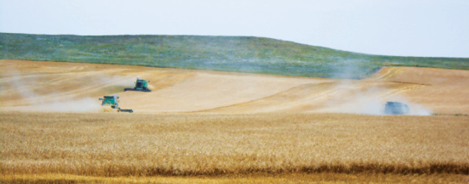
Mike Beer
Check The Specs...
NAME: Mike Beer
FARM: Beer Ranch
LOCATION: Keldron, S.D.
YEARS NO-TILLING: 24
CROPS: Spring wheat, winter wheat, corn, sunflowers, flax, millet, oats, green peas, yellow peas, chickpeas, soybeans and forage crops
In the late 1980s, farmers in my region seemed to be stuck on a production plateau, or were even losing ground. Everyone was growing only spring wheat or barley and leaving half their acres in black fallow every year.
The amount of wind and water erosion occurring on our rolling hills was discouraging. It just wasn’t economically feasible to continue in this manner.
At the time I was studying agronomy at South Dakota State University and was introduced to no-till through my classes. Dwayne Beck was just getting no-till research going at Dakota Lakes Research Farm in Pierre, S.D., and I interviewed several farmers that were trying out no-till for my senior seminar. I thought if they were no-tilling at Pierre maybe we could make it work a little further west, too.
Prior to no-till, seeding into stubble involved working it so the drill could get through. This either dried out the ground or created hard clumps. The resulting stand was very uneven and not very productive.
When I graduated from college in 1991 and started farming I also took a seat on the Corson County Conservation District board. I encouraged the board to invest in a John Deere 750 no-till drill that farmers could rent. I used that drill to get no-till going on my farm before I could afford my own. The right equipment made a big difference and it wasn’t long before I purchased my own John Deere 750 no-till drill.

BATTLING CLAY AND STUBBLE. Dawn row cleaners, MudSmith gauge wheels, Keeton seed firmers and spiked and solid closing wheels work together to make no-till planting a relative breeze in Mike Beer’s sticky clay soils that are covered with heavy residue from high-yielding crops.
Wheat Boost
I was one of the first ones to try no-till in my area and, like most new ideas, it was met with skepticism. Once I had a no-till drill and was able to get better seed placement, things started to improve. Prior to no-till I didn’t have a rotation at all. I raised predominately spring wheat, leaving a third of my acres in fallow and back-to-back seeding spring wheat on a third. If I got a good rain in the fall I would plant winter wheat.
By no-tilling I was conserving more moisture in my soils, making it possible to seed winter wheat. I soon added millet to my rotation.
One of the most dramatic early successes I had with no-till was that I doubled my winter wheat yields. Prior to no-till, a good year was a 30- to 35-bushel crop — now I can get 60- to 80-bushel winter wheat.
Several things factor into this dramatic boost. Standing stubble gathers more snow, resulting in more moisture in the soils, as well as keeping soil temperature more moderate. Without standing stubble I had to use really winter hardy varieties that were low yielding and more susceptible to disease.
With stubble providing more protection I could switch to less winter hardy, but higher yielding winter wheat varieties that were usually used more in northern Nebraska or southern South Dakota. Black ground got too cold and didn’t get enough snow cover for these varieties to be consistently successful with older farming techniques, but with no-till they have done very well.
Weed Wins
One of the biggest challenges with raising small grains year after year was weeds. Pigeon grass and wild oats were a major problem with no cheap or easy solution readily available. But the longer I no-tilled, the more moisture I was able to gather in my soils and the more comfortable I was trying out some new crops in my rotation. Once I did away with fallow I had a lot more acres to try new crops.
I tried some corn with limited success early on. Before no-till, raising corn for grain happened maybe 1 out of every 5 years in my area. No-till made corn more successful due to better soil moisture, but it wasn’t until around 1997 when Roundup Ready corn was more widely available that I truly added it to my rotation. Being able to use Roundup was a big help with weeds.
I have continued adding crops, including sunflowers, flax, green peas, yellow peas, chickpeas and, most recently, soybeans — which yielded 30 bushels per acre their first season even though it was a drier year and they received some hail damage.
Weed pressure has significantly declined as I’ve diversified crops. I never have more than 2 years of cool season grasses in a row and the seeding times vary by crop. I use a burndown prior to planting any crop.
Corn and sunflowers are planted later than spring wheat and the wild oats have already sprouted. I’m able to get good control of wild oats with pre-plant burndown and break up their cycle and prevent weed seed production. Once a major burden, wild oats and pigeon grass now aren’t even a blip on our weed radar.
All the variation in seeding and burndown timing has resulted in a significant reduction in weed pressure. Being able to use different chemistries with different crops has helped us get ahead of problem weeds. Plus, a great benefit of this system is that we are highly unlikely to develop herbicide-resistant weeds.
Diverse Perks
Crop diversity brings a lot of benefits to our farm. Besides breaking up weed cycles, we’ve also effectively made it very difficult for insects and disease to take hold on our acres. This results in reduced expenses for dealing with those issues and increased yields.
We have a lot of acres to cover, especially now that we don’t have any fallow ground. Planting a variety of crops allows us to spread out our labor and farm more acres without increasing equipment costs. I use the drill 4-6 months out of the year and run combines from July to late fall.
Having multiple crops seeded at different times also helps us play the odds with the weather. We almost always have something growing so we can take advantage of the rains when they come.
This past year was a great example. It was very dry in May and June, which is typically when we get the majority of our moisture. As a result, our wheat crop was affected. We caught a little rain in July. It was too late to help our wheat, but it was perfect for our corn, sunflowers and our first ever crop of soybeans. Those crops did very well. If we were only raising wheat, 2016 would have been a rougher year.
The specialty crops we’ve worked into our rotation can give a good economic boost, too, but they can be a bit of a hassle. If you have rocky ground, you have to roll it for the low-growing pulse crops and you really should have a flex header on your combine for harvest. I say I’m not going to mess with chickpeas again, but when they turn out well they pay well, so I find myself planting them again.
Due to disease issues, I don’t want to plant a pulse crop behind another broadleaf. I seed them into wheat stubble. It’s also important to think ahead with herbicides. Widematch works well on Canada thistle; however, it has carryover problems for pulse crops. We don’t want to use Widematch in a field that’s going to be planted to a broadleaf the following season.

GOING THE DISTANCE. Mike Beer limits his header size to 35 feet to ensure he can spread the chaff the width of his cut. Not spreading residue properly in no-till creates variability in moisture and soil temperature at planting and can harbor pests and diseases, the Keldron, S.D., no-tiller says.
Precise and Efficient
Farming a lot of acres pushes us to look for ways we can be more efficient with our time and inputs. This is something we take into consideration when it comes to equipment purchases and how we use our equipment.
Both our planter and drill are equipped with variable-rate technology. I studied soils in college so I use the variable-rate control to increase seeding and fertility rates on the fly on soils I know are capable of producing top yields. I’ve also done some soil testing based on soil type to provide prescription seeding and fertility maps for certain fields.
For wheat, I do a split application of fertilizer. The drill is setup so I can deep band starter fertilizer 3 inches below the seed.
There are three tanks on my drill: one for seed, one for starter and one for urea. I used to apply 225 pounds of urea with the drill, but could only get 40-50 acres per fill. I cut fertilizer back to just 100 pounds of urea at planting, getting 90 acres per fill and allowing faster planting.

PROFIT BOOSTERS. Pulse crops, such as green peas, yellow peas and chickpeas, can be challenging to grow, especially when it comes to harvesting the ground-hugging crops. But when they do well, they make up for the trouble with the prices they command, Mike Beer says.
I then come back and topdress urea and ammonia sulfate when wheat is in the 4-5 leaf stage to get the balance of fertility. Adding around 10 pounds of chlorine to this application helps plants more effectively combat disease.
Splitting up fertility hasn’t only been a time saver. The last couple years I’ve had excellent protein levels in my wheat. My goal is to get 15% protein on spring wheat to trigger premiums and 13% in winter wheat to avoid discounts.
Topdressing has really helped meet those protein goals for a couple of reasons. For one, not all soils have the capacity to hold on to a large amount of fertility, so applying it all at once can result in waste. By topdressing, the fertility is right there and available for the plant to use, especially if we get a little rain. And if we’re not having a great year, I might cut back on my rate, saving a little money.
I also tweak my fertility program to match crop rotation. Our corn always follows wheat and it needs lots of fertility. I fertilize winter wheat heavily, counting on some of that fertility to carry over for the corn crop. With no-till we have a lot of stubble and soil microbes that are able to hold onto the nitrogen (N); I feel confident I’m not wasting my investment. I do, however, use a N stabilizing product for those applications.
The corn takes full advantage of those nutrients and we follow that crop up with sunflowers. This works well because we actually limit fertility with sunflowers to help with standability. Too much N and sunflowers grow too fast, resulting in lodging issues.
Overall our fertility needs have decreased. For the first 5 years of no-till it seemed like I had to continually increase fertility rates to build yield. But after 5 years we hit a plateau on what soil tests said was needed. Our yields didn’t plateau, though. We’ve seen our yields continue to grow without having to increase our fertility rates.
I attribute this effect to increased microbial activity in our soils, making more nutrients available to our crops. This is evident not only in our yields, but the fact that over the years our soil organic matter has increased and our soils are mellower and softer than ever. Our soil tests keep showing more and more N is available despite us taking off big crops.
One of the most dramatic early successes with no-till was that I doubled my winter wheat yields…
Perfecting Equipment
Since starting no-till I’ve traded in drills, planters and combines several times, each time getting closer to equipment perfect for dealing with our specific conditions.
I purchased a John Deere 1775 no-till variable-rate planter for our row crops 2 years ago. It brought us the precision of variable-rate technology and row shutoffs to further reduce waste. It’s also much more precise. It can tell us how we’re doing with singulation and with the attachments we’re using we get very uniform seed placement.
We set it up with Dawn row cleaners, MudSmith gauge wheels, Keeton seed firmers and spiked and solid closing wheels. The Dawn openers are well built and easy to adjust. We have heavy, sticky clay soils, which make the MudSmith gauge wheels essential. Our planter’s gauge wheels used to plug up a lot when soils were a little damp. The self-cleaning MudSmith gauge wheels mean my son, Bo — the main planter operator — can plant through wet spots if he wants to and just keep going. The mud is thrown out of the holes in the wheels, effectively solving our sticky soil problem. They’re just amazing.

MONOTONY NO MORE. Once limited to only small grains, Mike Beer has now expanded his rotation to include corn, sunflowers, soybeans, flax, pulse crops and more. The variability has helped him get weed and pest issues under control and cast some financial safety nets for variable weather and markets.
At harvest one of our critical issues is making sure residue gets spread evenly. Our combine headers are 30- and 35-footers; as that’s the largest I feel I can use and still get a good, even residue spread. If I don’t get an even spread I get soils that are varying in temperature and moisture. Thick residue bands can also harbor insects and disease. To avoid this I limit header size and use modified straw spreaders on our John Deere 9770 combines that are able to stretch residue across the width of headers.
Changing Landscapes
Farming in my area has changed drastically in the 20-plus years I’ve been no-tilling. I’m no longer on my own. I’m happy to say around 95% of my area currently no-tills. The conservation district now rents out no-till drills, corn planters and even a manure spreader. Fallow is a rarity and driving down the road you can pick out a wide range of crops being grown.
People have built grain bins and purchased trucks and hoppers that just weren’t necessary before because they didn’t have the yields. I’m seeing more young people on area farms. Kids are actually staying because there’s opportunity. I think no-till is the only way to be economical and remain in business where we live. It’s certainly proven to be good for our area so far.







Post a comment
Report Abusive Comment